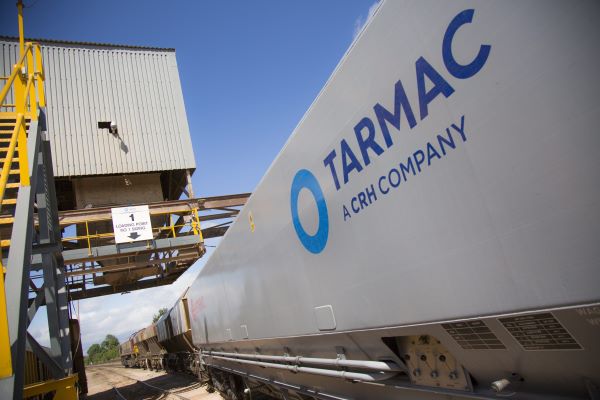The role of rail freight in supporting the decarbonisation of the construction industry on the road to net zero should not be underestimated, says Tarmac’s Chris Swan.
In a world learning to live with Covid-19 and its social and economic effects, it can be sometimes difficult to look for glimmers of silver linings. However, the crisis has undoubtedly demonstrated the national and strategic importance of rail freight infrastructure, shining a spotlight on just how vital the movement of essential goods and materials is to society and our wider economy.
A railway that has been geared towards ever increasing passenger numbers has, in recent months, seen rail freight operations prioritised over passengers for the first time. In economic terms the UK rail freight industry generates £1.6bn in productivity for the UK economy each year. Conversely, the environmental savings are significant, with the average freight train removing on average between 45 and 70 HGVs from the highway network and urban centres, and with them, the associated CO2.
Part of a green recovery
As we prepare for recovery, rail freight’s economic and environmental importance to all parts of society - particularly UK construction and infrastructure delivery - should be front of mind. More than 20 million tonnes of aggregates and cement are moved by rail each year, with an upward trend in the last decade resulting in a record-breaking month for construction material movements on the railway in March.
With infrastructure at the heart of recovery plans and a wider awareness of the role that rail freight plays in the sustainable transport of materials to urban centres, now is the time to build on the successes and ensure the contribution rail freight can make to a green recovery is unlocked.
Strategic planning
Taking full advantage of rail freight’s logistical and sustainability benefits for construction requires advanced strategic planning and protection from policymakers to maximise its potential.
Promised infrastructure investments across the country require powerful and efficient logistics networks to be realised. Engaging with materials providers at the earliest stages of schemes is critical to understanding the opportunity for rail freight logistics to support both more efficient and lower carbon delivery. Operational solutions need to be taken into consideration from the initial phase of construction project planning.
Access to sites and quality terminals are both vital, and clients and contractor design teams need to develop site designs that can support rail freight from the very outset. Clients should work more closely with supply chain partners to explore all appropriate options when developing comprehensive smart logistics programmes.
More immediately, the reduction in passenger services during the pandemic has resulted in spare capacity on the railway for freight services. This raises an important debate around how capacity is allocated going forward to ensure that the construction industry, and others, can take full advantage of the benefits the rail network by running more, longer and faster trains.
Prior to the legal challenge to its expansion, Heathrow was developing well considered and exciting proposals for a hubs programme that could connect rail-fed material supply around the UK. It’s important that all clients particularly in UK infrastructure don’t lose sight of the opportunity to embrace this type of thinking for other projects. Alongside this, there is a clear opportunity to gather and transfer the learnings from major projects which are embracing rail fed materials supply, such as HS2, Crossrail and Thames Tideway Tunnel, and embed the approach in the delivery of other regional construction projects.
Engaging policymakers
Politically, it’s important that elected members at both a regional and national level consider ways to put rail freight a key part of the planning process through, for example, the protection of existing railheads from inappropriate adjacent development. The number of available sites will continue to be a concern, particularly in cities where demand to support construction traffic is critical. Strategic rail locations must therefore be carefully identified and safeguarded.
This is particularly important as we look to infrastructure delivery to help build our way back to economic health right across the country, with ‘building back better’ a clear opportunity and call for action. The role of rail freight in supporting the decarbonisation of the construction industry, and wider society, on the road to net zero should not be underestimated.
At the same time as calling for action from policymakers to help move more on the rail network and clients to consider the benefits early in project planning stages, we’re actively supporting innovation and changes within our own control which support the delivery of a lower carbon built environment. These are aimed at improving efficiency and performance in the short and medium term by, for example, running longer trains, encouraging more fuel-efficient operations and looking to introduce innovations like electric rail vehicles.
The UK’s rail freight industry has played a critical role already in supporting the national response to Covid-19. For the construction materials industry, however, there is a clear opportunity to unlock further environmental and economic benefits by increasing the volume of goods transported by rail. The data tells us that progress is being made, but to ensure we can build on these successes, policymakers, materials suppliers and the wider industry must, collectively, step up the case for rail freight as one part of the green recovery.
Chris Swan is head of rail at Tarmac.


